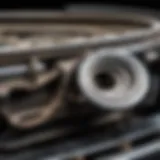Essential Guide to Replacing the Hyundai Solaris Bumper
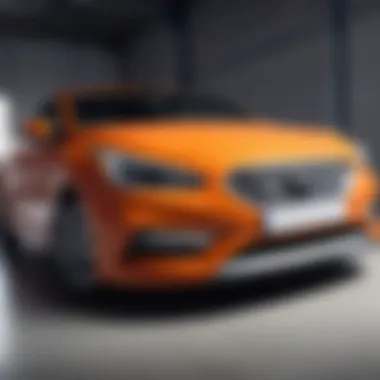

Intro
The bumper is an essential part of any vehicle, acting not only as a protective element but also contributing to the overall aesthetics of the car. The Hyundai Solaris, a popular car in various regions, is no exception. Understanding how to replace the bumper is crucial for ensuring the car's safety and integrity. This guide will cover the important aspects of bumper replacement, from choosing the right parts to effective installation and maintenance practices.
Обзор автомобиля
Основные характеристики
The Hyundai Solaris boasts a number of key features that appeal to a wide range of drivers. It combines functionality with a stylish design, offering a comfortable interior and user-friendly technology. With a focus on fuel efficiency, it has become a favorite for both city driving and long-distance journeys. The Solaris is known for its reliability, making it a popular choice among first-time car buyers and seasoned drivers alike.
Описание двигателей и трансмиссий
The Solaris is typically equipped with a range of engines that balance performance and efficiency. The most common options include 1.4 and 1.6-liter engines. These engines are coupled with both manual and automatic transmissions, providing flexibility based on driver preferences. The powertrains are designed to deliver a smooth driving experience while maintaining economical fuel consumption.
Выбор автозапчастей
Разновидности запчастей
When replacing the bumper, it is essential to understand the types of parts available. There are several options, including:
- OEM Parts: Original Equipment Manufacturer parts that ensure exact fit and compatibility.
- Aftermarket Parts: These can vary in quality and consistency. Research is needed to ensure you get a reliable option.
- Used Parts: Often more affordable but may come with varying degrees of wear that could impact performance.
Как выбрать качественные запчасти
Selecting high-quality parts is fundamental for the longevity and safety of your vehicle. Consider the following:
- Manufacturer Reputation: Choose brands known for their quality standards.
- Warranty Offers: A good warranty can indicate confidence in the product's durability.
- Reviews and Recommendations: Look for feedback from other drivers and mechanics regarding specific parts.
"Investing in good quality parts may seem more costly upfront but can save money in the long run through enhanced performance and reduced likelihood of further repairs."
Understanding the specific requirements for your Hyundai Solaris, including compatibility and the type of driving you do, will guide you in making an informed decision when replacing the bumper.
Overall, this guide intends to assist car enthusiasts, mechanics, and professionals in effectively navigating the process of bumper replacement. Armed with the right information, the task becomes less daunting and more manageable.
Prologue to Hyundai Solaris Bumpers
Understanding the significance of the Hyundai Solaris bumper is vital for every car owner, mechanic, and automotive enthusiast. The bumper acts as the first line of defense against minor collisions, debris, and impacts. It serves not just an aesthetic purpose but is critical for safety. Knowing what a bumper does and how it contributes to the overall integrity of the vehicle can dramatically influence decisions regarding repairs and replacements.
Definition and Purpose of Bumpers
A bumper is a protective component located at the front and rear of a vehicle. Its primary purpose is to absorb and mitigate impact during collisions, safeguarding essential parts of the vehicle, like the engine and fuel system, from damage. Additionally, bumpers help protect pedestrians in an accident. In modern vehicles like the Hyundai Solaris, bumpers often integrate advanced technology, featuring sensors and cameras for parking assistance and collision detection.
Importance of Quality Bumpers
The quality of the bumper directly affects its effectiveness in crash prevention and absorption of impact energy. High-quality bumpers are made from durable materials, ensuring they can endure daily wear and tear while providing optimum safety in emergencies. Choosing a reliable bumper is essential because lower quality options can fail in an accident, leading to severe damage or injury. Investing in a quality bumper not only enhances safety but can also contribute to insurance costs and the vehicle's resale value.
"A bumper is more than just a cosmetic feature; it plays a crucial role in vehicle safety and performance."
In summary, the bumper’s dual function of protection and safety makes it an integral part of the Hyundai Solaris. Whether replacing an old bumper or buying a new vehicle, understanding its role is imperative for maintaining vehicle integrity.
Understanding the Structure of the Bumper
Understanding the structure of the bumper is crucial for anyone involved in vehicle maintenance or repair. The bumper plays a substantial role in both the aesthetics and functionality of the car. It is not merely a cosmetic element; it serves as a protective barrier for the vehicle's frame and its occupants in the event of a collision. By comprehending how bumpers are constructed, one can appreciate their importance in automotive safety and performance. This knowledge is essential for making informed decisions regarding replacement or repair.
Components of the Bumper Assembly
A bumper assembly consists of several key components that work together to ensure maximum protection and functionality. These include:
- Bumper Cover: This is the outermost part that gives the bumper its appearance. It is often made of plastic or fiberglass and is designed to absorb minor impacts.
- Reinforcement Bar: Positioned behind the bumper cover, this metal bar provides structural support. It adds strength to the bumper and aids in energy absorption during collisions.
- Impact Absorbers: These are foam or rubber elements that are integrated into the assembly. They help to dissipate energy during impact, reducing the force transferred to the vehicle and its passengers.
- Mounting Brackets: These brackets secure the bumper to the vehicle's frame. They are essential for maintaining stability and proper alignment.
Understanding these components helps in choosing the right bumper and ensures that all elements operate efficiently together.
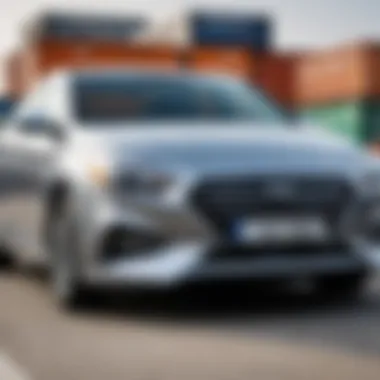

Materials Used in Bumper Construction
The materials used in the construction of bumpers are vital in determining their performance and durability. Typically, bumpers are made from:
- Thermoplastic Olefins (TPO): This material is commonly used for bumper covers. It is lightweight and known for its impact resistance. TPO can also be molded to various shapes, making it a flexible choice.
- Polyurethane Foam: Often used in impact absorbers, polyurethane foam helps absorb shocks in the event of a collision. Its characteristics allow it to return to its original shape after being compressed.
- Steel: For the reinforcement bar, steel provides the necessary strength. It can withstand significant forces without crumpling, making it essential for safety.
By selecting a bumper made from high-quality materials, you ensure that it performs well under stress, protecting both the vehicle and its occupants. Whether you are an enthusiast or a professional mechanic, understanding these materials can lead to better repair and replacement choices.
"A well-constructed bumper ensures your Hyundai Solaris can withstand the unpredictabilities of driving while also preserving its design."
Familiarity with the structure and materials of bumpers empowers vehicle owners to make educated decisions about installation, maintenance, and repairs.
Signs You Need a New Bumper
Recognizing when you need to replace the bumper on your Hyundai Solaris is crucial. A thorough understanding of the signs can prevent further damage and ensure safety. The bumper serves as the first line of defense during minor collisions. When it becomes compromised, it can no longer fulfill its intended role effectively. Thus, acknowledging the indicators of a worn or damaged bumper becomes essential for maintaining the functionality and safety of your vehicle.
Visual Damage Indicators
Visual damage is often the most noticeable sign that a bumper is in distress. The following aspects should draw your attention:
- Cracks and Dents: Look for obvious cracks or dents. Even small imperfections can indicate underlying issues that compromise bumper integrity.
- Paint Damage: Peeling paint or discoloration may signal that the bumper is aging or has experienced chemical exposure. These aesthetic issues often precede structural weaknesses.
- Misalignment: If the bumper appears misaligned with the car's body, it may have suffered impact. Misalignment can lead to gaps where debris can enter, damaging other components.
- Rust and Corrosion: Examine metal and plastic areas for rust or corrosion. These signs are especially pertinent in areas with harsh weather or salt exposure.
In summary, ensuring that the bumper remains visually intact is a part of basic vehicle upkeep. Regular inspections can preempt significant replacement needs.
Functional Impacts of a Damaged Bumper
A bumper's primary function extends beyond aesthetics; it plays a pivotal role in vehicle safety and performance. The implications of a damaged bumper are diverse and can affect the driving experience:
- Increased Vulnerability in Accidents: A compromised bumper may fail to absorb impact effectively. This increases the risk of damage to other parts of the car, such as the framework or the more vital internal components.
- Decreased Performance in Minor Collisions: In the event of a minor collision, a damaged bumper may not provide adequate protection. This can lead to more costly repairs later. A functional bumper absorbs shock and minimizes damage upon impact.
- Impacts on Safety Features: Modern vehicles often have sensors integrated into or around the bumper. If these sensors are damaged or misaligned, important safety features, like rear parking assistance, may be impaired.
- Impact on Driving Behavior: A loose or damaged bumper can create noises while driving. It may also alter the vehicle's handling, especially at higher speeds, putting the driver and others on the road at risk.
The regular assessment of bumper status is key to not only maintaining vehicle integrity but also ensuring safety for all road users. Should any of these signs become evident, it may be time to consider replacement options.
Choosing the Right Bumper for Hyundai Solaris
Choosing the right bumper for your Hyundai Solaris is vital for maintaining both aesthetics and functionality. A bumper serves not just as a shield against impacts but also contributes to the overall style of the vehicle. The decision between an Original Equipment Manufacturer (OEM) bumper and an aftermarket option can significantly affect your car's performance and appearance. Beneath this decision lies the consideration of costs, quality, and the potential impact on the vehicle's value.
OEM vs Aftermarket Options
Considering whether to go with an OEM or aftermarket bumper is a central decision. Here is an overview of both:
- OEM Bumpers
- Aftermarket Bumpers
- Made by the vehicle's manufacturer.
- Ensures a perfect fit that matches the original specifications.
- Often comes with a warranty, guaranteeing quality and support.
- Typically higher in price because they are tailored for specific models.
- Made by third-party manufacturers.
- May vary in quality, requiring diligent research before purchase.
- Often available at more affordable prices.
- Can offer varied designs and features that may not be available in OEM.
Factors to Consider in Selection
In selecting the right bumper for your Hyundai Solaris, several factors come into play:
- Compatibility
Ensure that the bumper is compatible with your specific model year. Check the part number as sometimes minor differences can exist between years. - Durability
Assess the materials used. Some bumpers are lighter but less durable, while others might be heavy but provide better protection. Polypropylene and thermoplastic are common materials that are resilient and impact-resistant. - Aesthetic Appeal
Consider how the bumper enhances the overall look of your vehicle. Some may prioritize original design, while others prefer customization. - Installation Requirements
Determine if the bumper can be easily installed by yourself or if professional help is required. Some aftermarket options may need additional modifications for fitment. - Price and Budget
Set a realistic budget before making decisions. Remember to also factor in potential extra costs such as labor if you're not installing it yourself.
In summary, take the time to weigh your options regarding OEM and aftermarket bumpers. Thoroughly evaluate compatibility, durability, aesthetics, and installation to ensure an optimal choice that benefits both function and style.
Cost Considerations in Bumper Replacement
When replacing the bumper on a Hyundai Solaris, understanding the cost considerations is crucial. These costs influence not only your budget but also the quality of the bumper you choose and the overall effectiveness of the replacement. The price can vary significantly based on various factors. These include the type of bumper, labor costs, and the additional expenses associated with the installation process. Parsing out these elements will provide clarity when making decisions about the bumper replacement.
Average Costs for Bumpers
The average cost of bumpers for the Hyundai Solaris varies depending on whether you choose an OEM or aftermarket option. OEM bumpers are generally more expensive due to their quality and fitment assurances. They usually range from $300 to $800. Aftermarket bumpers, while often more affordable, can range from $150 to $500. Factors such as the specific model year and additional features like sensors or integrated lighting may also affect pricing.
In considering the bumper type, you must factor in your priority. If quality and a precise fit are paramount, opting for OEM might be beneficial. However, if cost savings are the primary concern, aftermarket options could suffice, provided they meet safety standards.
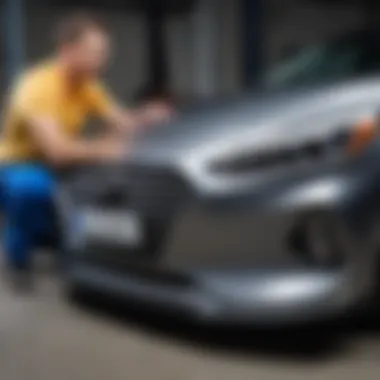

Additional Costs: Labor and Painting
In addition to the bumper cost, there are labor and painting expenses to anticipate. Labor charges can vary widely from one service provider to another. They generally range from $50 to $150 per hour depending on the mechanic’s experience and location. Installation usually takes around two to four hours. Thus, budget for $100 to $600 just for labor.
Painting the bumper can add to the overall cost, especially if color matching is required. Painting expenses can range from $150 to $300. It is essential to ensure the paint used is durable and weather resistant, as this will prevent premature fading and peeling.
Proper budgeting for all these factors can help avoid surprises.
In sum, being aware of the comprehensive costs associated with bumper replacement on the Hyundai Solaris allows for better financial planning and ensures that you can achieve the desired outcome without unexpected complications. Always compare prices, quality, and warranty options to maximize the value of your investment.
Preparing for Bumper Replacement
When considering the replacement of a bumper on a Hyundai Solaris, preparation is essential. This preparation phase lays the groundwork for a successful installation. Proper preparation can minimize issues during both removal and installation of the bumper. It ensures that the right tools are at hand and that the work environment is safe and efficient.
In this section, we will explore the tools you need and the necessary safety measures to keep in mind.
Tools Required
To replace the bumper, it is important to have the right tools ready. These tools will vary slightly based on the specific requirements of the job, but several key items are generally necessary:
- Screwdrivers: A set of Phillips and flathead screwdrivers will be used for removing screws.
- Socket Set: A socket wrench with different sizes is crucial for loosening bolts securely holding the bumper in place.
- Pliers: These are helpful for gripping and pulling any stubborn fasteners.
- Utility Knife: This can be useful for cutting any adhesive or tape obstructing the bumper's removal.
- Jack and Jack Stands: If the vehicle needs to be elevated, these are vital for safety during work.
- Safety Gloves: To protect your hands from sharp edges or rough surfaces.
- Safety Glasses: These prevent dust and debris from entering your eyes.
Having these tools ready will expedite the process and ensure that everything goes smoothly.
Safety Measures
Safety should rank as a top priority when preparing for bumper replacement. Engaging in car repair poses several risks, and taking precautions can prevent accidents. Here are some safety measures to consider:
- Work in a Well-Lit Area: A well-lit environment helps avoid mistakes and accidents during the process.
- Ensure Vehicle Stability: If you are using a jack, make sure the vehicle is securely elevated on jack stands. This prevents any chance of it collapsing while you work underneath it.
- Disconnect the Battery: To prevent any electrical issues, disconnect the negative terminal of the battery before starting. This also protects you if there are sensors on the bumper that could create a short while being handled.
- Wear Protective Gear: Always wear safety glasses and gloves. They facilitate a safer working experience.
- Avoid Loose Clothing: Ensure that nothing you wear could get caught in moving parts while working on the vehicle.
Adhering to these safety measures will enhance both your well-being and the efficiency of the bumper replacement process. Preparing adequately—by securing the right tools and ensuring safety—sets the stage for an effective and secure installation.
Step-by-Step Guide to Bumper Replacement
Replacing a bumper is not just about aesthetics; it plays a crucial role in your vehicle’s safety. This guide will equip you with practical knowledge for successfully replacing the bumper of your Hyundai Solaris. Understanding the process can help maintain the integrity and functionality of your vehicle. Here, we will outline the specific steps to remove the old bumper and install the new one.
Removing the Old Bumper
Before starting, ensure you have all necessary tools at hand. Basic tools required include a socket set, screwdrivers, pliers, and possibly a heat gun or a plastic trim removal tool. Begin by disconnecting the battery to avoid any electrical issues during bumper removal.
Steps for Removal:
- Open the Hood: This allows you to access screws that might be hidden.
- Locate the Fasteners: Check for screws or clips securing the bumper. These can generally be found on the top, sides, and underneath the vehicle.
- Remove Trim Pieces: If applicable, gently detach any trim pieces that may be covering fasteners.
- Unscrew the Fasteners: Using the appropriate socket or screwdriver, remove all fasteners, ensuring to keep them in a safe place for later use.
- Disconnect Wiring: If your bumper has integrated sensors or lights, carefully unplug their connectors before attempting to remove the bumper completely.
- Detach the Bumper: With all fasteners and wiring disconnected, gently pull the bumper away from the vehicle. You may need assistance if the bumper is heavy.
Installing the New Bumper
Once you have successfully removed the old bumper, the next phase is installing the new one. It typically involves a reverse process of removal but requires precision to ensure proper alignment and functionality. Before starting this step, compare the new bumper with the old one to confirm compatibility.
Steps for Installation:
- Position the New Bumper: Align the new bumper with the vehicle, ensuring the mounting points match.
- Reconnect Wiring: If the new bumper has lights or sensors, reconnect these components carefully to avoid damaging them.
- Secure the Bumper: Start by fastening the screws that you removed earlier. Tighten all screws to the manufacturer’s specifications.
- Reattach Trim Pieces: If any trim pieces were removed, reattach them securely.
- Check Alignment: Step back and ensure the bumper is aligned correctly with the body of the vehicle.
- Reconnect the Battery: Finally, reconnect your battery and test any electronic features on your new bumper.
Following these structured steps will help ensure that your new bumper is properly installed, enhancing both the appearance and safety of your Hyundai Solaris.
Post-Installation Checks
After successfully replacing the bumper on your Hyundai Solaris, it is critical to perform post-installation checks. These checks ensure that everything is functioning properly and that the bumper is securely attached. Proper post-installation verification can prevent future issues and prolong the life of your new bumper.
Ensuring Proper Fitment
The first aspect to check is the fitment of the bumper. An improperly installed bumper can lead to alignment issues, which may affect your vehicle’s overall appearance and functionality. When examining the fit, ensure that:
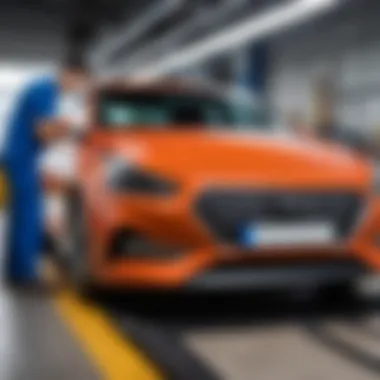

- The bumper aligns seamlessly with adjacent panels, with no gaps or overlaps.
- All mounting clips and screws are tightly fastened, preventing any rattling or movement.
- The bumper's curves and lines match those of the vehicle body without any noticeable discrepancies.
If any misalignment is found, carefully reassess the installation steps. Adjusting the fitment usually involves loosening and repositioning the bumper, followed by re-tightening it to achieve proper alignment.
Testing Bumper Functionality
The next step involves testing the functionality of the new bumper. This verification ensures that all features associated with the bumper operate effectively. Important items to confirm include:
- Sensor Calibration: If your Hyundai Solaris is equipped with parking sensors, verify that they function correctly. Test them by backing up slowly to see if any alerts are triggered.
- Lighting Check: Inspect any built-in lights, such as fog lights or reflectors, making sure they illuminate as intended.
- Impact Resistance: Although it may not be practical to test this directly, observe how the bumper appears under various conditions (such as heavy rainfall or extreme temperatures). Ensure there are no signs of warping or loosening.
"Ensuring both fitment and functionality is vital after replacing the bumper. Proper checks can save future headaches and costly repairs."
Maintenance Tips for Bumpers
Maintaining the bumper of your Hyundai Solaris is essential. It not only preserves the aesthetics of your vehicle but also ensures safety. Bumpers are designed to absorb impact during minor collisions. However, they are also exposed to various elements that can cause wear and damage. Regular maintenance helps prolong their life and maintain their functionality. Below, we will delve into cleaning and care practices as well as damage inspection methods that are crucial for a bumper's upkeep.
Cleaning and Care
Keeping your bumper clean is a straightforward yet vital maintenance task. Dirt, grime, and other contaminants can cause scratches or dull the finish. Here are some cleaning tips:
- Use Mild Soap: Wash the bumper using a mild automotive soap and water to avoid harsh chemicals that may damage the surface.
- Soft Cloth or Sponge: Use a soft cloth or sponge to prevent scratches while cleaning.
- Regular Rinse: Rinse the bumper properly after washing to remove all soap residue.
- Waxing: Consider applying a coat of automotive wax occasionally for added protection against UV rays and environmental elements.
- Avoid Pressure Washers: High-pressure washing can damage the bumper or dislocate it. Always use gentle cleaning methods.
By maintaining cleanliness, you not only improve the vehicle's appearance but also protect the bumper's integrity over time.
Inspecting for Damage
Regular inspections for damage are also crucial for bumper maintenance. Identifying issues early can save you from costly repairs later. Here’s how to effectively inspect your bumper:
- Visual Inspection: Walk around the vehicle and look for visible cracks, dents, or scuffs on the bumper surface.
- Check for Loose Parts: Gently shake the bumper to see if it feels loose. If it does, you may need to tighten or replace attaching hardware.
- Functionality Tests: Ensure that any integrated features such as sensors work properly. Malfunctions could indicate damage beneath the surface.
- Look for Rust or Corrosion: Inspect all areas, especially where paint has chipped, to prevent further rust development.
Proper inspection can reveal potential problems, making timely repairs easier and less expensive.
Finale
The conclusion of this article is crucial as it summarizes the key aspects of bumper replacement for the Hyundai Solaris and highlights the benefits of proper maintenance. A bumper serves essential functions: it provides protection to the vehicle and enhances safety for its occupants. Understanding the importance of maintaining your bumper is vital in preserving the overall integrity of your vehicle.
Recap of Key Points
- Importance of Bumpers: Bumpers protect both the vehicle and its occupants. They absorb impact and can save significant repair costs.
- Signs for Replacement: It is essential to know the signs that indicate a bumper needs replacing. This can include visible damage or functional impairments that affect vehicle safety.
- Choosing the Right Bumper: The choice between OEM and aftermarket options is significant. Each has its implications on quality and cost, affecting the long-term value of your vehicle.
- Installation Process: Following the correct procedure for removing and installing a bumper ensures safety and functionality. Proper fitment checks post-installation are vital to ensure everything is in good order.
- Maintenance Tips: Regular cleaning and inspection can prevent minor issues from turning into major problems, helping to prolong the lifespan of your new bumper.
Final Thoughts on Bumper Maintenance
The final insights on bumper maintenance highlight the ongoing responsibilities of vehicle ownership. Regular maintenance not only preserves the appearance of the bumper but also ensures that it provides the necessary protection in the event of an accident. Simple tasks, such as cleaning, can be performed by the owner. More complex inspections may require a professional's expertise. By prioritizing bumper care, Hyundai Solaris owners can extend the life of their vehicle's essential components and therefore enhance its resale value. This forward-thinking approach to vehicle maintenance ultimately reflects an owner's commitment to quality and safety.
Resources for Further Reading
In the landscape of automotive maintenance, particularly when it comes to the Hyundai Solaris bumper replacement, access to the right resources forms the backbone of a well-informed process. Knowledge and insights gathered from various reputable sources can greatly enhance one’s understanding and execution of the tasks at hand. This section aims to underscore the importance of having resourceful guides and articles readily available for enthusiasts and professionals alike.
First, consulting guides helps to outline detailed procedures that are often specific to vehicle models. These resources often provide illustrations and schematics that can be crucial during the installation process. Furthermore, they can present tips and tricks that seasoned mechanics have gathered over the years, giving a significant edge to both novice and experienced individuals tackling bumper replacement for the first time.
Second, articles that focus on type comparisons, such as the distinctions between OEM and aftermarket bumpers, serve to inform the decision-making process. Readers can gain insights into the longevity, cost-effectiveness, and compatibility of each part, which are essential considerations when selecting a bumper.
Lastly, engaging with peer-reviewed information or community-driven forums can offer real-world experiences that are invaluable. These platforms allow for interaction and firsthand accounts of issues and solutions encountered during bumper replacement, enriching the learning experience.
In summary, well-curated reading materials not only enhance knowledge but also equip individuals with practical skills that contribute to effective bumper replacement and maintenance.
Recommended Guides and Articles
To successfully navigate the intricacies of bumper replacement for the Hyundai Solaris, certain guides stand out for their clarity and detail. Among the highly valued resources:
- Hyundai Service Manuals: These manuals are a primary resource, offering authoritative and detailed procedures tailored to the specific model.
- YouTube Tutorials: Several automotive channels provide visual step-by-step instructions. Watching these can help solidify the understanding of procedures discussed in text.
- Reddit Communities: Engaging with user-generated content on platforms such as Reddit can uncover real user experiences and practical advice on bumper replacement journeys.
Where to Find Replacement Parts
Acquiring quality replacement parts is a critical element of the bumper replacement process. Various avenues offer access to parts compatible with Hyundai Solaris:
- Authorized Dealerships: These are ideal for OEM parts which guarantee fit and quality, albeit usually at a higher price.
- Online Retailers: Websites like AutoZone or RockAuto provide a wide array of options, from OEM to various aftermarket parts, often with competitive pricing.
- Local Auto Parts Stores: Stores like O'Reilly Auto Parts or Advance Auto Parts can have immediate availability, allowing for quick access.
- Facebook Marketplace: Sometimes, users can find used parts that are still in good condition. However, caution should be exercised to ensure the purchase is genuine.
Using these resources wisely can streamline the bumper replacement process and ensure that the finished product meets quality standards.


